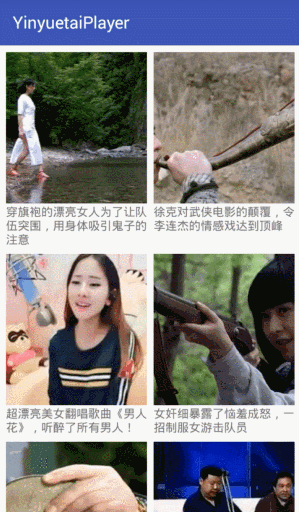概述
新版的音悦台 APP 播放页面交互非常有意思,可以把播放器往下拖动,然后在底部悬浮一个小框,还可以左右拖动,然后回弹的时候也会有相应的效果,这种交互效果在头条视频和一些专注于视频的app也是很常见的。
前几天看网友有仿这个 效果,觉得不错,现在分享出来,代码可以再优化,这里的播放器使用的是B站的ijkplayer,先上两张动图。

当图片到达底部后,左右拖动
 实现的思路
实现的思路首先,要是拖动视图缩小的效果,我们肯定需要自定义一个View,而根据我们项目的场景我们这里需要两个View,一个是拖动的View,另一个是浮动上下的View(可以缩小的View),为了实现拖动,我们知道必定会用到ViewDragHelper这个类,这个类专门为了拖动而设计的。
然后,对于拖动到底部的View,我们需要实现左右拖动的效果,这个其实也是比较容易实现的,我们通过ViewDragHelper的onViewPositionChanged方法来判断当前视图的状况,就可以做View进行缩放和渐变了。
代码分析首先我们会自定义一个容器,容器的init方法会初始化两个View:mFlexView (到底拖动的View)和mFollowView (跟随触摸缩放的View)
private void init(Context context, AttributeSet attrs) {final float density = getResources().getDisplayMetrics().density;final float minVel = MIN_FLING_VELOCITY * density;ViewGroupCompat.setMotionEventSplittingEnabled(this, false);FlexCallback flexCallback = new FlexCallback();mDragHelper = ViewDragHelper.create(this, 1.0f, flexCallback);// 最小拖动速度mDragHelper.setMinVelocity(minVel);post(new Runnable() {@Overridepublic void run() {// 需要添加的两个子View,其中mFlexView作为拖动的响应View,mLinkView作为跟随ViewmFlexView = getChildAt(0);mFollowView = getChildAt(1);mDragHeight = getMeasuredHeight() - mFlexView.getMeasuredHeight();mFlexWidth = mFlexView.getMeasuredWidth();mFlexHeight = mFlexView.getMeasuredHeight();}});}ViewDragHelper 的回调需要做的事情比较多,在 mFlexView 拖动的时候需要同时设置 mFlexView 和 mFollowView 的相应变化效果,在 mFlexView 释放的时候需要处理关闭或收起等效果。所以这里我们需要对ViewDragHelper个各种回调事件进行监听。这也是本功能最核心的:
private class FlexCallback extends ViewDragHelper.Callback {@Overridepublic boolean tryCaptureView(View child, int pointerId) {// mFlexView来响应触摸事件return mFlexView == child;}@Overridepublic int clampViewPositionHorizontal(View child, int left, int dx) {return Math.max(Math.min(mDragWidth, left), -mDragWidth);}@Overridepublic int getViewHorizontalDragRange(View child) {return mDragWidth * 2;}@Overridepublic int clampViewPositionVertical(View child, int top, int dy) {if (!mVerticalDragEnable) {// 不允许垂直拖动的时候是mFlexView在底部水平拖动一定距离时设置的,返回mDragHeight就不能再垂直做拖动了return mDragHeight;}return Math.max(Math.min(mDragHeight, top), 0);}@Overridepublic int getViewVerticalDragRange(View child) {return mDragHeight;}@Overridepublic void onViewReleased(View releasedChild, float xvel, float yvel) {if (mHorizontalDragEnable) {// 如果水平拖动有效,首先根据拖动的速度决定关闭页面,方向根据速度正负决定if (xvel > 1500) {mDragHelper.settleCapturedViewAt(mDragWidth, mDragHeight);mIsClosing = true;} else if (xvel < -1500) {mDragHelper.settleCapturedViewAt(-mDragWidth, mDragHeight);mIsClosing = true;} else {// 速度没到关闭页面的要求,根据透明度来决定关闭页面,方向根据releasedChild.getLeft()正负决定float alpha = releasedChild.getAlpha();if (releasedChild.getLeft() < 0 && alpha <= 0.4f) {mDragHelper.settleCapturedViewAt(-mDragWidth, mDragHeight);mIsClosing = true;} else if (releasedChild.getLeft() > 0 && alpha <= 0.4f) {mDragHelper.settleCapturedViewAt(mDragWidth, mDragHeight);mIsClosing = true;} else {mDragHelper.settleCapturedViewAt(0, mDragHeight);}}} else {// 根据垂直方向的速度正负决定布局的展示方式if (yvel > 1500) {mDragHelper.settleCapturedViewAt(0, mDragHeight);} else if (yvel < -1500) {mDragHelper.settleCapturedViewAt(0, 0);} else {// 根据releasedChild.getTop()决定布局的展示方式if (releasedChild.getTop() <= mDragHeight / 2) {mDragHelper.settleCapturedViewAt(0, 0);} else {mDragHelper.settleCapturedViewAt(0, mDragHeight);}}}invalidate();}@Overridepublic void onViewPositionChanged(final View changedView, int left, int top, int dx, int dy) {float fraction = top * 1.0f / mDragHeight;// mFlexView缩放的比率mFlexScaleRatio = 1 - 0.5f * fraction;mFlexScaleOffset = changedView.getWidth() / 20;// 设置缩放基点changedView.setPivotX(changedView.getWidth() - mFlexScaleOffset);changedView.setPivotY(changedView.getHeight() - mFlexScaleOffset);// 设置比例changedView.setScaleX(mFlexScaleRatio);changedView.setScaleY(mFlexScaleRatio);// mFollowView透明度的比率float alphaRatio = 1 - fraction;// 设置透明度mFollowView.setAlpha(alphaRatio);// 根据垂直方向的dy设置top,产生跟随mFlexView的效果mFollowView.setTop(mFollowView.getTop() + dy);// 到底部的时候,changedView的top刚好等于mDragHeight,以此作为水平拖动的基准mHorizontalDragEnable = top == mDragHeight;if (mHorizontalDragEnable) {// 如果水平拖动允许的话,由于设置缩放不会影响mFlexView的宽高(比如getWidth),所以水平拖动距离为mFlexView宽度一半mDragWidth = (int) (changedView.getMeasuredWidth() * 0.5f);// 设置mFlexView的透明度,这里向左右水平拖动透明度都随之变化changedView.setAlpha(1 - Math.abs(left) * 1.0f / mDragWidth);// 水平拖动一定距离的话,垂直拖动将被禁止mVerticalDragEnable = left < 0 && left >= -mDragWidth * 0.05;} else {// 不是水平拖动的处理changedView.setAlpha(1);mDragWidth = 0;mVerticalDragEnable = true;}if (mFlexLayoutPosition == null) {// 创建子元素位置缓存mFlexLayoutPosition = new ChildLayoutPosition();mFollowLayoutPosition = new ChildLayoutPosition();}// 记录子元素的位置mFlexLayoutPosition.setPosition(mFlexView.getLeft(), mFlexView.getRight(), mFlexView.getTop(), mFlexView.getBottom());mFollowLayoutPosition.setPosition(mFollowView.getLeft(), mFollowView.getRight(), mFollowView.getTop(), mFollowView.getBottom());//Log.e("FlexCallback", "225行-onViewPositionChanged(): 【" + mFlexView.getLeft() + ":" + mFlexView.getRight() + ":" + mFlexView.getTop() + ":" + mFlexView//.getBottom() + "】 【" + mFollowView.getLeft() + ":" + mFollowView.getRight() + ":" + mFollowView.getTop() + ":" + mFollowView.getBottom() + "】");}}接下来是处理测量和定位,我们实现的排列效果类似 LinearLayout 垂直排列的效果,这里需要对 measureChildWithMargins 的 heightUse 重新设置;onLayout 的时候在位置缓存不为空的时候直接定位是因为 ViewDragHelper 在处理触摸事件子元素在做一些平移之类的,若是有元素更新了 UI 会导致重新 Layout,因此在 FlexCallback 的 onViewPositionChanged 方法记录位置,然后在回弹的时候需要通过Layout 恢复之前的视图。
@Overrideprotected void onMeasure(int widthMeasureSpec, int heightMeasureSpec) {int desireHeight = 0;int desireWidth = 0;int tmpHeight = 0;if (getChildCount() != 2) {throw new IllegalArgumentException("只允许容器添加两个子View!");}if (getChildCount() > 0) {for (int i = 0; i < getChildCount(); i++) {final View child = getChildAt(i);// 测量子元素并考虑外边距// 参数heightUse:父容器竖直已经被占用的空间,比如被父容器的其他子 view 所占用的空间;这里我们需要的是子View垂直排列,所以需要设置这个值measureChildWithMargins(child, widthMeasureSpec, 0, heightMeasureSpec, tmpHeight);// 获取子元素的布局参数final MarginLayoutParams lp = (MarginLayoutParams) child.getLayoutParams();// 计算子元素宽度,取子控件最大宽度desireWidth = Math.max(desireWidth, child.getMeasuredWidth() + lp.leftMargin + lp.rightMargin);// 计算子元素高度tmpHeight = child.getMeasuredHeight() + lp.topMargin + lp.bottomMargin;desireHeight += tmpHeight;}// 考虑父容器内边距desireWidth += getPaddingLeft() + getPaddingRight();desireHeight += getPaddingTop() + getPaddingBottom();// 尝试比较建议最小值和期望值的大小并取大值desireWidth = Math.max(desireWidth, getSuggestedMinimumWidth());desireHeight = Math.max(desireHeight, getSuggestedMinimumHeight());}// 设置最终测量值setMeasuredDimension(resolveSize(desireWidth, widthMeasureSpec), resolveSize(desireHeight, heightMeasureSpec));}@Overrideprotected void onLayout(boolean changed, int l, int t, int r, int b) {if (mFlexLayoutPosition != null) {// 因为在用到ViewDragHelper处理布局交互的时候,若是有子View的UI更新导致重新Layout的话,需要我们自己处理ViewDragHelper拖动时子View的位置,否则会导致位置错误// Log.e("YytLayout1", "292行-onLayout(): " + "自己处理布局位置");mFlexView.layout(mFlexLayoutPosition.getLeft(), mFlexLayoutPosition.getTop(), mFlexLayoutPosition.getRight(), mFlexLayoutPosition.getBottom());mFollowView.layout(mFollowLayoutPosition.getLeft(), mFollowLayoutPosition.getTop(), mFollowLayoutPosition.getRight(), mFollowLayoutPosition.getBottom());return;}final int paddingLeft = getPaddingLeft();final int paddingTop = getPaddingTop();int multiHeight = 0;int count = getChildCount();if (count != 2) {throw new IllegalArgumentException("此容器的子元素个数必须为2!");}for (int i = 0; i < count; i++) {// 遍历子元素并对其进行定位布局final View child = getChildAt(i);MarginLayoutParams lp = (MarginLayoutParams) child.getLayoutParams();int left = paddingLeft + lp.leftMargin;int right = child.getMeasuredWidth() + left;int top = (i == 0 ? paddingTop : 0) + lp.topMargin + multiHeight;int bottom = child.getMeasuredHeight() + top;child.layout(left, top, right, bottom);multiHeight += (child.getMeasuredHeight() + lp.topMargin + lp.bottomMargin);}}触摸事件的处理,由于缩放不会影响 mFlexView 真实宽高,ViewDragHelper 仍然会阻断 mFlexView 的真实宽高的区域,所以这里判断手指是否落在 mFlexView 视觉上的范围内,在才去调 ViewDragHelper 的 shouldInterceptTouchEvent 方法。
@Overridepublic boolean onInterceptTouchEvent(MotionEvent ev) {// Log.e("YytLayout", mFlexView.getLeft() + ";" + mFlexView.getTop() + " --- " + ev.getX() + ":" + ev.getY());// 由于缩放不会影响mFlexView真实宽高,这里手动计算视觉上的范围float left = mFlexView.getLeft() + mFlexWidth * (1 - mFlexScaleRatio) - mFlexScaleOffset * (1 - mFlexScaleRatio);float top = mFlexView.getTop() + mFlexHeight * (1 - mFlexScaleRatio) - mFlexScaleOffset * (1 - mFlexScaleRatio);// 这里所做的是判断手指是否落在mFlexView视觉上的范围内mInFlexViewTouchRange = ev.getX() >= left && ev.getY() >= top;if (mInFlexViewTouchRange) {return mDragHelper.shouldInterceptTouchEvent(ev);} else {return super.onInterceptTouchEvent(ev);}}@Overridepublic boolean onTouchEvent(MotionEvent event) {if (mInFlexViewTouchRange) {// 这里还要做判断是因为,即使我不阻断事件,但是此Layout的子View不消费的话,事件还是给回此LayoutmDragHelper.processTouchEvent(event);return true;} else {// 不在mFlexView触摸范围内,并且子View没有消费,返回false,把事件传递回去return false;}}同时我们需要对滚动事件进行监听,我们需要在此关闭的整个平移执行事件。
@Overridepublic void computeScroll() {if (mDragHelper.continueSettling(true)) {invalidate();} else if (mIsClosing && mOnLayoutStateListener != null) {// 正在关闭的情况下,并且拖动结束后,告知将要关闭页面mOnLayoutStateListener.onClose();mIsClosing = false;}}/** * 监听布局是否水平拖动关闭了 */public interface OnLayoutStateListener {void onClose();}public void setOnLayoutStateListener(OnLayoutStateListener onLayoutStateListener) {mOnLayoutStateListener = onLayoutStateListener;}/** * 展开布局 */public void expand() {mDragHelper.smoothSlideViewTo(mFlexView, 0, 0);invalidate();}而在实际的应用中要实现回弹后详情页面的效果,我们需要自己实现一个组合View,这个大家可以自己看源码音悦台源码
以上就是本文的全部内容,希望对大家的学习有所帮助,也希望大家多多支持脚本之家。

